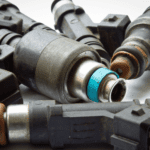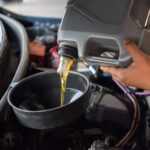Transmission fluid leaks can be a real problem to pinpoint, especially when it’s not obvious where the leak is coming from. However, there might be more than one reason behind low or dropping transmission fluid levels. Apart from leaks, the fluid can also burn off if the transmission is faulty and overheating.
While uncommon, it’s worth remembering that transmission fluid can evaporate due to excessive heat. Therefore, conducting a thorough diagnosis is important before jumping to conclusions. Finding the source may not be easy in the case of a leak, but in some cases, the issue can be resolved with minimal effort or expense. In this article, I’ve highlighted the best places to look for a leak or what might be causing the transmission to overheat, resulting in fluid loss.
What Does A Low Transmission Fluid Level Mean?
A low transmission fluid level can indicate a leak in the transmission system caused by a damaged seal or gasket, or it could be due to overheating the transmission, causing the fluid to evaporate. In rare cases, the transmission level may be low because it was never at the correct level.
However, a leak is the most common reason for transmission fluid loss. For the transmission to overheat to the point that it causes the transmission fluid to evaporate, it would need to exceed 200 degrees Fahrenheit (93 degrees Celsius), which is high for a car’s transmission.
What Can Cause the Transmission to Overheat, Resulting in Fluid Loss?
Some of the problems that can cause a transmission to overheat and result in fluid loss are:
- Low fluid levels
- Clogged transmission fluid lines
- Damaged gears
- Towing heavy loads for long periods
A point to note with overheating transmission and why it rarely occurs is the car would be almost undrivable in these circumstances. You’ll have heard the crunching and whirring noises from the transmission long before it overheats.
Where Can Transmission Fluid Leak From?
There can be a few causes of leaking transmission fluid and the places to check:
Transmission pan gasket
The transmission pan gasket is a rubber or cork seal between the transmission pan and the housing. They commonly deteriorate with age. It can be pretty simple to replace but does require completely removing the pan to replace the gasket.
Leaking drain plug
This could even be as simple as the drain plug is loose and requires retorquing to the correct setting. You or the mechanic who last had this undone may not have tightened this correctly.
Cracked casing
A crack in the transmission gearbox housing would only usually happen in an impact. This could happen by driving over debris on the road.
Leaking drive shaft seals
Each driveshaft attached to the transmission has a seal; these can perish and deteriorate over time. The other cause for a leaking drive shaft seal can be the result of other repairs to the vehicle, such as CV gator replacement.
Damaged orRustytransmission pan
A rusty transmission pan needs no explanation, especially on older vehicles. Damage will occur from impact; the transmission is well protected in an engine bay but still can come into contact with foreign objects.
Leaking transmission fluid lines
Some transmission setups have lines from the gearbox to the radiator to cool the transmission fluid, mainly in high-performance vehicles, but it is worth checking that your car doesn’t have this system.
What Happens If You Drive With A Low Transmission Fluid Level?
Driving with low transmission fluid can lead to a range of issues and potentially serious damage to your vehicle’s transmission system. Transmission fluid is essential for lubricating and cooling the moving parts within the transmission and ensuring smooth gear shifts. Here are some potential consequences of driving with a low transmission fluid level:
- Poor Lubrication – Transmission fluid lubricates the transmission’s gears and other components. Insufficient lubrication can increase friction and heat, leading to premature wear and damage.
- Overheating – Low transmission fluid levels can cause the transmission to overheat, as the fluid also helps to dissipate heat generated during operation. Overheating can lead to further fluid breakdown and damage to internal components.
- Slipping Gears – Inadequate fluid levels may cause the transmission to struggle to engage and disengage gears properly. This can result in slipping gears, erratic shifting, and difficulty maintaining the correct gear ratios.
- Increased Friction and Heat – The transmission components can generate more heat than usual with less fluid to reduce friction. This heat can accelerate wear and tear on the transmission, leading to the degradation of seals, gaskets, and other components.
- Component Damage – Transmission components such as gears, bearings, and seals can get damaged over time without proper lubrication and cooling. This damage may result in costly repairs or even a complete transmission replacement.
- Reduced Performance – A vehicle with low transmission fluid may experience reduced overall performance, including sluggish acceleration, rough shifting, and decreased fuel efficiency.

How to Check a Transmission Fluid Leak
Checking for a transmission fluid leak is a relatively simple process, and you can easily diagnose the issue by inspecting the underside of the vehicle. First, I recommend checking the transmission fluid level. If it is low, check when it was last changed. Can you confirm it was at its maximum level when it was last changed or topped up? If yes, it is advisable to fill the fluid level to the maximum and monitor it over the next few days. If you observe that the level starts to drop, it will confirm the presence of a leak.
You’ll need to get down and look underneath the vehicle for a better view of the transmission. You may be able to diagnose exactly where the leak is coming from. However, you need to get the car up on a lift to get a clear view of all the auxiliaries to the transmission.
How to Check and Top up the Transmission Fluid
Topping up the transmission fluid is simple but can be complicated by other parts in the way. Some may need to be removed to get to the filling point.
- Park the vehicle on a flat level surface; the car will need to be warm, but ideally, not on; your vehicle user manual will confirm if it needs to run or not.
- Locate the dipstick at the top or on the side of the transmission; it will usually be smaller than the engine oil dipstick.
- Remove the dipstick clean with a rag, and replace for a few seconds.
- Carefully remove the dipstick and hold it horizontally but angled with the tip; the fluid level should be easily visible.
- If a top-up is required, your user manual will confirm the correct transmission fluid and the location of the filling point.
- Top up Fluid. Some transmission fluid bottles have a large spout to simplify filling. If they don’t, get yourself a spout that fits, top up in small amounts at a time, and give the fluid a minute to settle.
- Recheck the level. Repeat the filling process if necessary.
Repairing a Transmission Fluid Leak
There are thickening agents available that can seal minor transmission fluid leaks. However, it should be noted that these agents are only effective in fixing minor gasket leaks and hairline cracks. Additionally, it is essential to remember that these sealant fluids provide a temporary fix and may not work in the long run. In fact, minor leaks generally worsen over time.
Unfortunately, most transmission fluid leaks require replacing a component to fix the issue. Sometimes, the transmission may need to be removed from the vehicle to repair it. Therefore, it is highly recommended that a qualified mechanic be consulted to carry out the repair work.
Bottom Line
The answer to whether transmission fluid can be low without a leak is yes, but it is extremely rare. The transmission can overheat if another part is faulty, but this needs to be so bad the vehicle is undrivable. Really, the reason it would be low without a leak is human error not putting the right amount in.
A leaky transmission needs urgent attention, but before you panic, it is best to confirm the leak by refilling, checking the level, and using this article to check each component for leaks.









